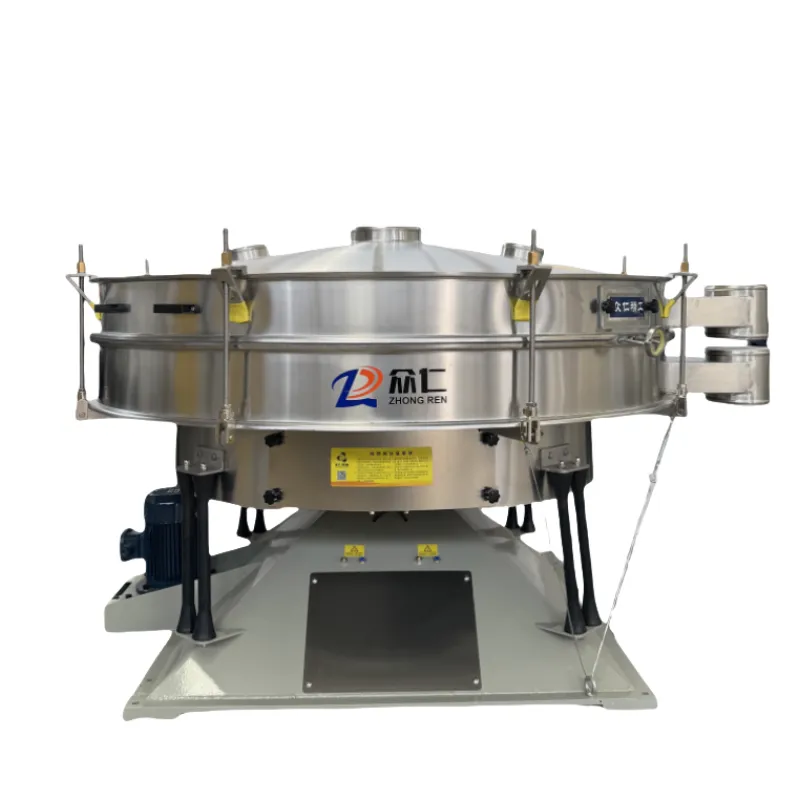Негизги Принциптери Шайкүлөш экраны машинасы
Сүзгүчтөрдүн максаттарын жана экрандын максатын аныктоо
Техника бирдүү жана ар түрдүү материалдарды классификациялай алат. Негизги максаттар — бузулуштарды жок кылуу, фракциялоо жана ары дальнагы өнөктөшү үчүн даярдоо. Ийгиликтүү сүзүлүү гравитациялык күчтөрдүн жана механикалык кыймыл-аракет принциптеринин аралашып иштешинен пайда болот. Бөлүү тактыгы, кеңири аймакта бөлүү мүмкүнчүлүгү, түйүндүрүүгө кыйын болгон материалдар менен иштөө мүмкүнчүлүгү. Ар бир максатка жараша оптималдык бузулуштарды энергияны чыгымдоо жана өтүмдүүлүктү арттыруу жолу менен багыттоо керек.
Кенен таралган өндүрүштүк экран түрлөрү жана кыймыл-аракет динамикасы
Титрөө/кругтук орбиталдуу жана тербелмелүү терезе экрандар негизинен өнөр жай үчүн колдонулат. Сыртка чыгаруу үчүн сызыктуу титрөө жана экранды 1 бир гана чыгыш жолу аркылуу колдонуу үчүн өтө таасирдүү. Эгер экранды рамага бекитсеңиз болот, анда кругтук касиеттер да сунуш кылынат. Эйленип турган экрандар төмөнкү жыштыктагы титрөө менен айлануунун балансын камсыз кылат, ал титрөө, текшөө, кругтук кыймылды өзгөртүүнү камтыйт. Бул өзгөртүүлөр салмакка жараша жана ылайыкташтыруу аркылуу ишке ашырылат. Толук кездейсоқ бурч, киргизүү өлчөмү, өндүрүү бир тектүү, тазалоо эффективдүүлүгү жогорку. Тербелмелүү экран ынтымаксыз иштейт, колдоо колай, машина эмгек интенсивдүүлүгүн азайтуу үчүн колдонулат. Алардын спиралдуу-багыттуу бирдей спиралдери бөлүкчөлөр сымдардын ортосунда калып калышын болтока элестетет жана конвенциялык вибраторлордо кездешкен бузулуштарды тиимдүү түрдө азайтат.
Тербелмелүү экран машинасынын механикасы жана функциясы
Тербелүү механизмин жана тербелүүнүн жыштыгын түшүнүү
Тербелмелүү экрандар мотордун айланышын ремендик эксцентрик тегерек системасы аркылуу горизонталдык тербелмелүүгө которот, төмөнкү жыштыктагы (4-12 Гц) чоң амплитудалуу айланма тербелүү алууга мүмкүнчүлүк берет. Бул эллиптикалык траектория материалды жан-жаңылык жагынан бирдей таратып, экрандын бетинде убакытты узартууга жана нәзик же майда бөлүкчөлөрдү бөлүүгө жардам берет.
Ылгак же нам жабдуулар үчүн тандоо чебери
Сызыктуу эмес тербелүү траекториясы нам материалдардын жабышуусун азайтат. Бөлүкчөлөр вертикальды шамалар менен тийип тургандан көрө ачылыштар аркылуу катуу кыймыл менен өтөт, бул капиллярдык байланыштын алдын алат. Бул ыкма жогорку жыштыктагы тербелмелүү экрандарга салыштырмалуу чалгындоо окуяларын 85% кемитет.
Өткөрүмдүлүк анализи: Чын жагдайда өлчөнгөн дараят
Кичи испыттөө бирдиги саатына 4-10 тонна, ал эми өнөржай конфигурациялар чоң фракциялык материалдар үчүн 150 тонна/сааттен ашат. Бирдей материалды таратуу аркылуу анын чакан көлөмүндө туруктуу (±5% чейинки айырма) эффективдүүлүк сакталынат жана эң жогорку көрсөткүчтөрдө ажыратуу тактыгы сакталып калат.
Тереңдетилген түрдөгү тербелмелүү сеткалардын механизми
Сызыктуу жана айлана тербелүү шаблондорунун түшүндүрмөсү
Тербелмелүү сеткалар ар кандай материалдар үчүн айырмаланган кыймыл шаблондорун колдонушат. Сызыктуу тербелүү так өлчөмдөгү кепчирүүчү материалдар үчүн, ал эми айлана тербелүү орточо же чоң фракциялык материалдардын өтүмдүүлүгүн арттырат. Белгилүү бир моделдер жарым-жартылай нымдуу киргизилген материалдар сыяктуу кыйын шарттар үчүн эллиптикалык тербелүүнү колдонушат.
Сүзгүчтүн сыйымдуулугу жана эффективдүүлүгү боюнча динамикалык модельдү талдоо
Дискреттүү элемент ыкмасы (DEM) сыяктуу эсептөө моделдөө вибрациялык күчтөрдүн таасири астында бөлүкчөлөрдүн аракетин моделирлөө аркылуу сетканын иштөө эффективдүүлүгүн оптималдаш үчүн колдонулат. DEM методу чектүү элемент анализи (FEM) менен бирге конструкциялык тозууну болжолдоого жана кен кармалуу жана кайра кабыл алуу операцияларында вибрациялык бузулуштарды калыбрлаш үчүн колдонулат.
Материал менен ылайыкташтык: Киргизүүгө ылайык тандаш
Бөлүкчөлөрдүн формасынын, тыгыздыгынын жана таралышынын таасири
Дүз эмес формадагы бөлүкчөлөр көрүнбөө көйгүсүн күчөйтөт. Жогорку тыгыздыктагы материалдар тозууну тездетет, ал эми ар түрдүү өлчөмдөгү бөлүкчөлөр катмарлаштырылышына тоскоолдук кылат. Бирдей өлчөмдөгү жайгаштыруулар бөлүүнү оптималдаштырат, ал эми ар түрдүү өлчөмдөгү материалдар өзгөртүүлөргө муктаж болот.
Сетканын чүйкөсүнүн өлчөмүн жана материалды тандааны оптималдаш
Сетканын чүйкөсүнүн өлчөмү тактык менен өтүмдүлүктү тең сакташы керек – абдан майда болушу көрүнбөөгө, абдан чоң болушу сапатты төмөндөтөт. Сетка материалдарын тандаш кезинде тозуу куркунучу менен ылайыкташтырыңыз:
| Материалдын куркунучу | Сетка чечими | Чыгарыш |
|---|---|---|
| Жогорку тозуу | Полиуретан беттер | 3àболгондо болотко салыштырмалуу узун турмуш узактыгы |
| Химиялык катуулар | Коргошун менен капталган сымдар | Коррозиялык чокулардын болушун алдын алат |
| Татаалдык менен тейлөөчү жемдер | Ачык аймактардын торлору | Ылгакты сактоону 40% кемитет |
Масштабдоодон мурун кичине партияларды текштөө керек, уюштуруу талап кылынат
Операциялык жана экономикалык кароо-тейлөө
Түрдүү тоскоолдуктар менен кароо-тейлөөнүн чыгымдарын тактоо
Серептегичтер 600 0Б/МИН) төмөнкү жыштыктарда иштейт, дыбысты 25-30% кемитет жана титирдөөчү торлорго салыштырмалуу кароо-тейлөөнү 35% кыскартат. Алардын жөнөкөй механикасы бөлүктөрдүн тозушун кемитет, эксплуатациялык мөөнөтүн узартат.
Кичи материалдарды бөлүү боюнча таасирдүү көрсөткүчтөр
Тербелмелүү решеткалар 95-97% эффективдүүлүккө ээ 100 решеткеден кичи бөлтөрлөр үчүн, азгына жабышкан. Нымдуу балчык үчүн алар тербелмелүү решеткаларга караганда 20-25% артык өткөрүм күчүнө ээ, бирок энергияны 18% аз пайдаланышат жумшак материал агымы .
Тербелмелүү решетка машинасынан тышкары негизделүүчү факторлор
Заводдун мейкиндигин жана берилип жаткан материал өлчөмүнүн чектөөлөрүн баалоо
Компактты модулдук конструкциялар тар мейкиндиктер үчүн жарашкан, ал эми берилип жаткан материалдын өлчөмү решетка түрүн аныктайт – жылгак материалдар (<5 мм) жынын катмарларын, чоң бөлтөрлөр (>150 мм) карата чыдамдуу конструкцияны талап кылат.
Чыгымдар: Энергияны пайдалануу менен узак убакыт пайдалануу баалуулугу
Тербелмелүү решеткалар энергияны 15-20% аз пайдаланат, бирок баштапкы чыгымдар жогорку болушу мүмкүн. Чыдамдуу компоненттерди сатып алуу (мисалы, тозууга каршы торлор) пайдалануу мөөнөтүн 200% ке узартып, узак мүдөөлүк баалуулукту жакшыртат.
Сүзгүчтөр технологиясынын келечегинде
Ийгиликтерге ИА-нын тербелүү контролү, өзүн-өзү тазалоо системалары жана модулдуу долбоордор кирет. Энергияны үнөмдөөчү инновациялар горно жана чакан таштар секторундагы операциялык стандарттарды кайрадан калыбына келтирүүгө тийиш, анын болжолу боюнча глобалдык индустриялык тесмеле шарттары .
ККБ
Тесмеле машиналарынын негизги максаттары эмне?
Негизги максаттарга кирп кеткен заттарды алуу, материалдын даражасын классификациялоо жана гравитация менен механикалык кыймыл аркылуу аны төмөнкү агым үчүн даярдоо кирет.
Тербелмелүү тесмеле машиналары кантип иштейт?
Тербелмелүү тесмелелер мотордун айланышын ремендик эксцентрикалык тегерек системасы аркылуу горизонталдуу жазык тербелүүгө которот, бул тербелмелүү кыймыл аркылуу материалдын тесмеле бетинде убакытты узартат.
Сырткы тесмелелердин кандай түрлөрү көп колдонулат?
Тербелмелүү, айланма орбиталдык жана тербелмелүү тербелмелүү тесмелелер жыш ыплас, алардын ар бири материалдар менен колдонуу жөндөмдүүлүктөрүнө ылайык ар кандай тербелүү шаблондорун жана пайдасын сунуш кылат.
Тесмеле торунун өлчөмү кантип оптималдаштырылат?
Мөөгүнүн чокусунун өлчөмү тактык жана өткөрүмдүүлүк үчүн балансталышы керек. Ал көбөйтүлгөндө чектөөнү жана тазалыкты камсыз кылуу үчүн кичине партияларды сыноодон кийин тандалышы керек.
Айлана тарткычтардын экономикалык артыкчылыктары эмне?
Айлана тарткычтар вибрациялык тарткычтарга караганда аз электр ток колдонот жана аз түрмө түзөт. Баштапкы чыгым жогорку болушу мүмкүн болсо да, алардын прочность компоненттери кызмат көрсөтүү мөөрүн күрсөтүүгө убакыт берет, узак мөөрдүү маани берет.
Көрсөтмө
- Негизги Принциптери Шайкүлөш экраны машинасы
- Тербелмелүү экран машинасынын механикасы жана функциясы
- Тереңдетилген түрдөгү тербелмелүү сеткалардын механизми
- Материал менен ылайыкташтык: Киргизүүгө ылайык тандаш
- Операциялык жана экономикалык кароо-тейлөө
- Тербелмелүү решетка машинасынан тышкары негизделүүчү факторлор
- Сүзгүчтөр технологиясынын келечегинде
- ККБ

